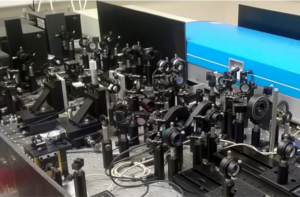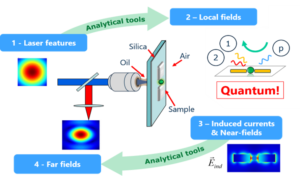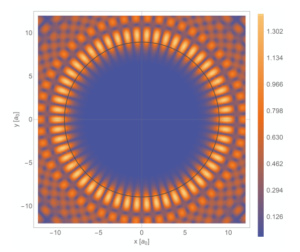- Accueil
- Institut Néel
- Équipes de recherche
- Pôles & Services techniques
- Travailler à l’institut
- Partenariats
- Actualités
- Agenda
- Annuaire
Toward entangled photon pair generation @ nanoscale
One of the major challenges faced in the development of quantum computers and quantum communication is the integration of devices for generating single photons and photon pairs. In this context, a drastic reduction of the size of devices entails a significant drop in their efficiency of photon generation. One way to overcome this challenging obstacle is to excite local electric field by coupling the emitter to plasmonic nano-antennas.

Recently we have achieved this objective by coupling an emitter which is a non-linear nanocrystal to nano-antennas by placing it within the gap of two antennas. Hence, creating a hybrid nano-structure in order to generate an enhancement by a factor that is 1000 times higher than an isolated nanocrystal. Therefore, the objective of the project is to use experimental as well as theoretical or numerical tools to further optimize second order non-linear processes such as second harmonic generation (SHG) and spontaneous parametric down conversion (SPDC) to enhance their efficiency to several orders of magnitude higher than what is already demonstrated. If successful, this would enable the first ever detection of photon pairs with the so called hybrid plasmonic nanostructure using the experimental setup that we have built.

The groundwork towards achieving this goal has already been completed with the pioneering work conducted during the course of three thesis defended in 2018 and 2019. With the development of a quantitative and numerical tool, the optimal configuration to obtain a strong coupling between the non-linear crystal and plasmonic antenna can be determined. This step therefore involves adapting the developed numerical programmes to new plasmonic antenna configurations, in particular, bowtie and to also search for the best materials (Al, Au, Ag) to obtain plasmonic resonances as well as for nonlinear nanocrystals (in particular for nano-iodates developed by Géraldine Dantelle and organic crystals synthesized by Alain Ibanez at the Néel Institute or for other compounds developed by already established collaborations). In the next step, the hybrid structures will be fabricated at the NanoFab platform of the institute using a technique that was recently realized which allows to place the nano-antennas with precision around the desired non-linear crystal as per its efficiency. In the final step, the hybrid nano-structures will be characterized for SHG emission (using an experimental setup and a technique that has already been realized with extremely reliable results) as well as for SPDC if sufficient enhancement is obtained which will allow us to demonstrate for the first time the generation and detection of photon pairs in hybrid plasmonic nano-structures. While the last aspect is ambitious, its theoretical study would already constitute a significant advance towards applications in quantum engineering.

Contact: guillaume.bachelier@neel.cnrs.fr
Cette page est vide.
Since their introduction in 1986 optical tweezers become a standard tool for non-invasive manipulation in biology, chemistry, and soft-mater physics. Nowadays, optical tweezers are widely used for trapping dielectric micro-particles or biological cells. The paramount interest of optical tweezers was underlined by the attribution of Nobel Prize in 2018 to A. Ashkin, the inventor of optical tweezers.
The first optical fiber tweezers was proposed in 1993 by A. Constable. This complementary approach shows some interesting features such as the very straightforward experimental implementation and the eased realization of counter-propagatig beam tweezers with reduced light intensities. Moreover, the optical fibers emit the trapping beam close to the trapping position. Optical aberrations are, thus, reduced, the illuminated volume is constricted, and trapping can be realized at almost any position in a complex environment such as an biological cell. high flexibility. Finally, the use of nano-structured optical fiber allows us to tailor the emitted optical beams.
At Institut Néel we are developing different optical fiber tweezers in single and dual fiber geometries and using divergent or focused beams. Our tweezers are applied to trap efficiently dielectric particles of different sizes (60 nm to 1 µm) or shapes (spheres and rods). Furthermore, the anisotropy and polarization depended emission of free, only optically trapped, rare earth-doped nanorod is studied.
In collaboration with our French and international colleagues we are currently exploring optical trapping using advanced microstructured fibers. In particular, fibers with 3D printed optical elements are showing exceptional performances to realize single fiber tweezers or trapping beams with optical angular momentum. Concerning the trapped objects, we are extending our ongoing characterization of fluorescent dielectric particles to trapping of gold nanoparticles or biologic species such as E.colie bacteria or living alga.
Please find more information on http://perso.neel.cnrs.fr/jochen.fick/
Quantum foundations and the de Broglie-Bohm interpretation: Classical/relativistic analogs of quantum physics
What does it really mean to accept standard quantum mechanics, as it is taught in textbooks, as the final words on the subject? Quantum mechanics is often considered as weird and bizarre and it is said to be unintelligible with usual classical causality and determinism in space-time. In this usual way of thinking there is no possibility to go back to the old mechanical description of Newton, Laplace or Einstein.
However, there is an elegant alternative way to describe quantum mechanics which is going back to Louis de Broglie in 1925-27 [1] and to David Bohm in 1952 [2,3] : In this interpretation particles follow well defined trajectories guided by wavefunctions, and quantum statistics are (like in classical statistical mechanics) associated with uncertainties and ignorance on the exact motions of the particles [6,7]. Furthermore, there is no genuine randomness and there is no measurement problem in this interpretation. This theory often named Bohmian mechanics (even though it should be called “de Broglian”) is empirically equivalent to the usual interpretation at least for non-relativistic quantum mechanics.
In our ongoing research we study the work of de Broglie and Bohm on several grounds :
All these exciting ongoing projects are opening new avenues for a better understanding of quantum mechanics.

Figure 1: An example [11] for a particle trajectory (black circle) driven by a complex field acting as a guiding wave function (color map). This theory is directly motivated by the old de Broglie work [1,9] on double solution and by current hydrodynamical quantum analogs projects [4].
For contacts and discussions about physics, history, and philosophy, and for applying to jobs and internships : aurelien.drezet@neel.cnrs.fr
Few general references:
[1] L. de Broglie, La mécanique ondulatoire et la structure atomique de la
matière et du rayonnement, J. Phys. Radium 8, 225-241 (1927).
[2] D. Bohm, A suggested interpretation of the quantum theory in terms of
“hidden” variables. I, Phys. Rev. 85, 166–179 (1952).
[3] A. Drezet, B. Stock, A causal and continuous interpretation of the quantum theory: About an original manuscript by David Bohm sent to Louis de Broglie in 1951, Ann. Fond. de Broglie 46, 169-195 (2021).
[4] J.W.M. Bush, A.U. Oza, Hydrodynamic quantum analogs, Rep. Prog. Phys. 84, 017001 (2020).
Our current work :
[5] A. Drezet, About Wigner Friend’s and Hardy’s paradox in a Bohmian approach: a comment of “Quantum theory cannot consistently describe the use of itself”, Int. J. Quant. Found. 5, 80-97 (2019).
[6] A. Drezet, Brownian motion in the pilot wave interpretation of de Broglie and relaxation to quantum equilibrium, Ann. Fond. de Broglie 43, 23-50 (2018).
[7] A. Drezet, Justifying Born’s rule Pα = |Ψα|2 using deterministic chaos, decoherence, and the de Broglie-Bohm quantum theory, To appear in Entropy 2021 https://arxiv.org/abs/2109.09353
[8] A. Drezet, Lorentz-Invariant, Retrocausal, and Deterministic Hidden Variables, Found. Phys. 49, 1166–1199 (2019).
[9] A. Drezet, the guidance theorem of de Broglie, Ann. Fond. de Broglie 46, 65-85 (2021).
[10] A. Drezet, P. Jamet, D. Bertschy, A. Ralko, and C. Poulain, Mechanical analog of quantum bradyons and tachyons, Phys. Rev. E 102, 052206 (2020).
[11] P. Jamet, A. Drezet, A mechanical analog of Bohr’s atom based on de Broglie’s double-solution approach, Accepted for publication in Chaos: An Interdisciplinary Journal of Nonlinear Science (2021) https://arxiv.org/abs/2106.08997
Few videos concerning our work:
https://www.youtube.com/watch?v=otqOQQQzrOs
https://www.youtube.com/watch?v=K57WwSXZCCY
Our research activities are based on the electromagnetic and mechanical properties of matter where at least one spatial dimension is reduced to a few tense nanometers and therefore rely on near-fields. This includes the study of plasmonics, with chiral/nonlinear/quantum responses, opto-mechanics from optical tweezers to macroscopic (quantum) oscillators which are coupled to light and/or spins of NV centers, nanomagnets and skyrmions. These are examples of systems that we investigate in the team by combining experiments, simulations and theoretical approaches at the forefront of the international research.

Position type: Stages Master-2 & Thèse
Contact: Arcizet Olivier - 0476881243 | Pigeau Benjamin - 0476881243
Le groupe de recherche Nano-optomécanique quantique hybride de l’Institut Néel explore une voie dans laquelle des nanofils de carbure de silicium sont couplés au spin électronique d’un centre coloré du diamant, le centre NV (pour Nitrogen-Vacancy)…
Position type: Stages Master-2 & Thèse
Contact: Arcizet Olivier - 04 76 88 12 43 | Pigeau Benjamin - 04 76 88 12 43
Proposition de stage, Nano optomechanics in the single photon regime
Light is a tool of choice to measure the minute vibrations of mechanical oscillators using optical interferometry. A laser field interacting with a resonator applies an optical force which formally represents the backaction of the measurement process. Optomechanics is the field studying the quantum limits of these precision measurements carried out in interferometers and optical cavities.
Position type: Stages Master-2 & Thèse
Contact: Jochen Fick - 04 76 88 10 86 | -
Over the last years, optical tweezers became an essential non-invasive observation, characterization and manipulation tool in microbiology, chemistry and solid-state physics. In particular, optical tweezers permit to get deeper insight into biological species such as cells, viruses, or bacteria.
In this context, we have developed an original optical tweezers approach based on nanostructured optical fibers. In this technique, the trapping light beam is emitted by an optical fiber close to the trapped species, thus limiting optical aberrations and other problems when working in crowded media. Recently we applied this fibered optical tweezers for investigating bacteria of the Pseudomonas genius. They are of particular interest because they harbors an efficient unique flagellum and diverse extracellular appendages including Type 4 pili also involved in motility.
Person in charge: Benjamin PIGEAU
Permanents
Olivier ARCIZET
Personnel Chercheur - CNRS
olivier.arcizet [at] neel.cnrs.fr
Phone: 04 76 88 12 43
Office: K-203
Guillaume BACHELIER
Personnel Chercheur - UGA
guillaume.bachelier [at] neel.cnrs.fr
Phone: 04 56 38 71 46
Office: D-411
Aurélien DREZET
Personnel Chercheur - CNRS
aurelien.drezet [at] neel.cnrs.fr
Phone: 04 56 38 70 62
Office: D-407
Jochen FICK
Personnel Chercheur - CNRS
jochen.fick [at] neel.cnrs.fr
Phone: 04 76 88 10 86
Office: D-418
Benjamin GREVIN
Personnel Chercheur - CNRS
benjamin.grevin [at] neel.cnrs.fr
Phone: 04 76 88 78 40
Office: D-412
Florence MARCHI
Personnel Chercheur - UGA
Florence.Marchi [at] neel.cnrs.fr
Phone: 04 76 88 10 85
Office: D-311
Benjamin PIGEAU
Personnel Chercheur - CNRS
benjamin.pigeau [at] neel.cnrs.fr
Phone: 04 76 88 12 43
Office: K-203
Signe SEIDELIN
Personnel Chercheur - UGA
signe.seidelin [at] neel.cnrs.fr
Phone: 04 56 38 71 44
Office: D-421
Arnaud AMBLARD
Personnel Chercheur - UGA
arnaud.amblard [at] neel.cnrs.fr
Phone: 04 56 38 70 52
Office: F-401
Referent: Aurélien DREZET
Thibault CAPELLE
Personnel Chercheur - CNRS
thibault.capelle [at] neel.cnrs.fr
Referent: Olivier ARCIZET
Tim DARTOIS
Personnel Chercheur - UGA
tim.dartois [at] neel.cnrs.fr
Phone: 04 56 38 70 52
Office: F-401
Referent: Aurélien DREZET
Cattleya DOUSSET
Personnel Chercheur - UGA
cattleya.dousset [at] neel.cnrs.fr
Phone: 04 56 38 71 80
Office: D-413
Referent: Olivier ARCIZET
Clément FOURNIOLS
Personnel Chercheur - UGA
clement.fourniols [at] neel.cnrs.fr
Referent: Benjamin PIGEAU
Lucas JUDEAUX
Personnel Chercheur - UGA
lucas.judeaux [at] neel.cnrs.fr
Phone: 04 76 88 74 28
Office: D-216
Referent: Olivier ARCIZET
Giovanni OLIVETTI
Personnel Chercheur - UGA
giovanni.olivetti [at] neel.cnrs.fr
Phone: 04 76 88 79 14
Office: K-207
Referent: Benjamin PIGEAU
Gabriel SOARES
Personnel Chercheur - CNRS
gabriel.soares [at] neel.cnrs.fr
Referent: Benjamin PIGEAU
